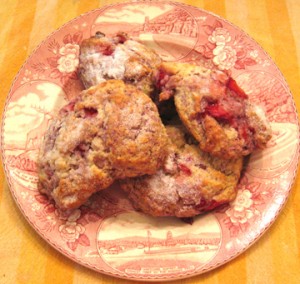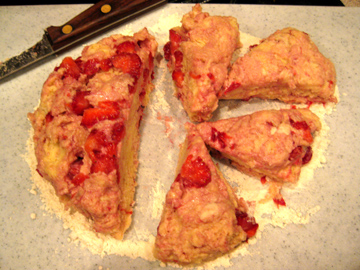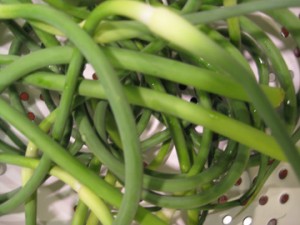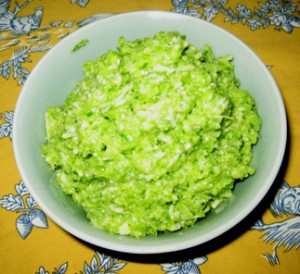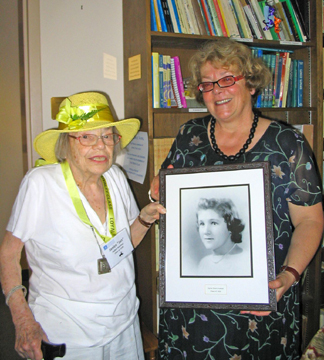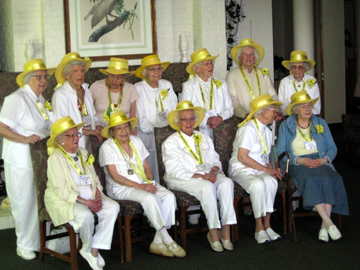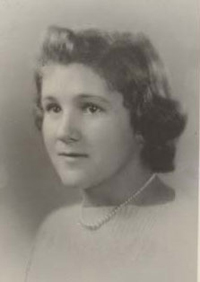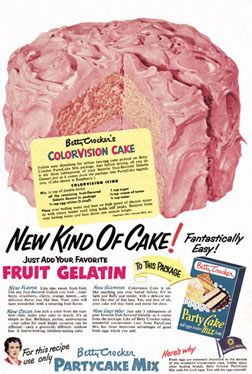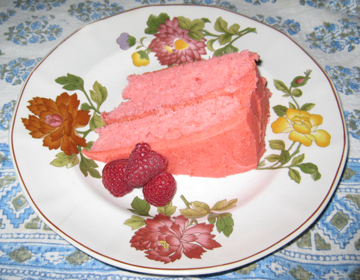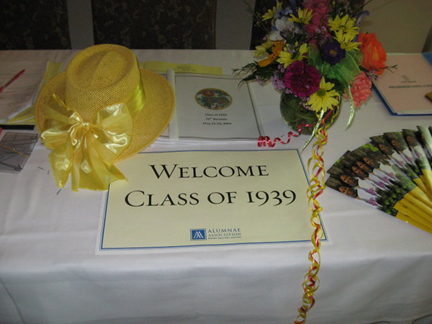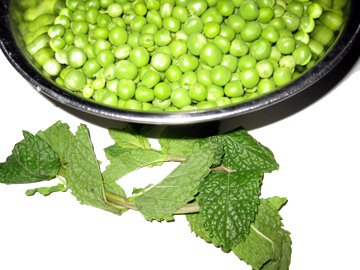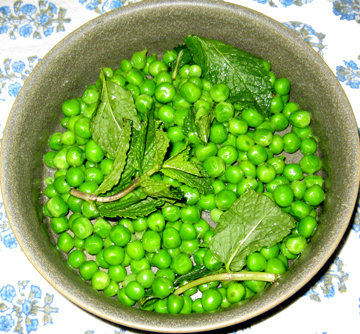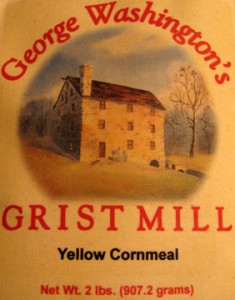
Sunday was Father’s Day and I was in Virginia so I decided to spend a little time with the Father of Our Country at Mount Vernon. I have always felt a kinship with George Washington. My grandmother kept a statue of Washington in a niche next to her front stairs in Rutland, Vermont. As children we were required to salute “General George” every time we passed it.
I had visited Mount Vernon several times before. I had never been to Washington’s gristmill, a few miles down the George Washington Parkway, before. The sunny day, a little cool for June in Virginia, provided the perfect occasion for my first trip there.
Myriad tour buses were piled up outside the main mansion at ten in the morning, but the gristmill had a smaller crowd. Manager Steve Bashore, interpreter Travis Shaw, and their colleagues had plenty of time to explain the workings of the mill. They also shared a bit of history about the site with visitors.
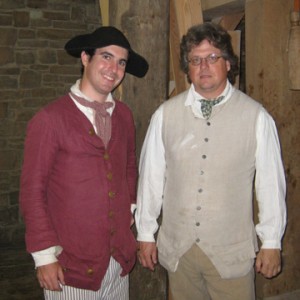
Steve Bashore (right) and Travis Shaw
In the 1760s Washington showed he was ahead of his time as a southern agriculturalist by changing his main crop from tobacco to wheat. The reasons were threefold. First, as students of American history know, tobacco quickly depletes nutrients in the soil. Washington was a pioneer in composting and crop rotation, but even so he must have had trouble with this difficult crop. Tobacco is also extremely labor intensive; indeed, its cultivation is one of the reasons the American South became so dependent on slavery.
Finally, in the 1760s tobacco from the future United States had to be sold through British tobacco merchants. These traders paid colonial planters in luxury goods rather than cash and could not secure a guaranteed price. Washington was frustrated with this system, in which he generally lost money.
When he changed over to wheat and other diversified crops he was able to sell to more markets, rotate his crops, and increase harvests (wheat could be planted twice a year). In 1771 he added to the profitability of his grains by opening a mill so that he could sell not just the raw agricultural products but also the edible commodities they became.
Visiting the gristmill reminded me what a smart man Washington was. He had a clear vision of an American economy that integrated agriculture and industry. As the interpreters were quick to point out, the gristmill represented not only a brilliant agricultural move on Washington’s part; it also looked ahead to the coming industrial revolution.
In 1791 Washington became the third person to purchase an innovative milling system designed by Oliver Evans, one of our nation’s first patent holders. The water-powered Evans mill enabled Washington to mechanize every part of the process of milling grain—moving the grain into storage, cleaning it, grinding it, cooling it, and sorting it.
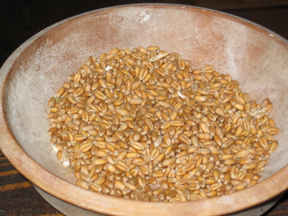
Wheat Before Milling
By the mid-19th century the Evans process had been replaced by operations that were bigger in scale, and the mill built by Washington fell into disrepair. It was eventually torn down, and its stones were used for new construction. In 1932 the site was acquired by the Commonwealth of Virginia, which reconstructed the mill and the miller’s house on the original foundations in honor of the 200th anniversary of Washington’s birth.
In 1997 the state decided that Mount Vernon could take better care of the structure, which was then restored. The extensive renovations included a reconstruction of the Oliver Evans mill, which I saw in action on my visit. It is apparently the only such mill working in the country today.
Steve Bashore, who runs the mill, is eloquent about both of the passions that brought him to Mount Vernon—history and milling. He spends much of his time trying to make the mill more efficient. He also spends much of it perusing records at Mount Vernon that can illuminate the day-to-day workings of the mill in the late 18th century.
Steve has plans to make and sell new products soon at the mill, including grits and a pancake mix. (He also hopes to sell rye whiskey from Washington’s distillery next door!) I intend to return when those are available.
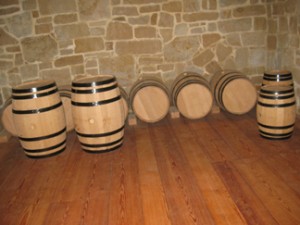
Kegs in the Distillery
In the meantime I was able to purchase some of the mill’s yellow cornmeal at the gristmill’s gift shop. Yesterday I used it to make one of George Washington’s favorite dishes, hoe cakes.
Hoe cakes are pancakes made of cornmeal mush. They supposedly got their name from the fact that African-American slaves (who were usually allocated a ration of cornmeal as part of their diet) would sometimes prepare them on fires using the flat part of a hoe.
Here is what Mount Vernon’s web site says about Washington and hoe cakes:
General Washington’s typical breakfast has been described by members of his immediate family and several guests. His step-granddaughter, Nelly Custis Lewis, who was raised at Mount Vernon, wrote “He rose before sunrise, always wrote or read until 7 in summer or half past seven in winter. His breakfast was then ready – he ate three small mush cakes (Indian meal) swimming in butter and honey, and drank three cups of tea without cream.” She described the recipe in a letter as:
“The bread business is as follows if you wish to make 2 1/2 quarts of flour up-take at night one quart of flour, five table spoonfuls of yeast & as much lukewoarm water as will make it the consistency of pancake batter, mix it in a large stone pot & set it near a warm hearth (or a moderate fire) make it at candlelight & let it remain until the next morning then add the remaining quart & a half by degrees with a spoon when well mixed let it stand 15 or 20 minutes & then bake it – of this dough in the morning, beat up a white & half of the yilk of an egg – add as much lukewarm water as will make it like pancake batter, drop a spoonful at a time on a hoe or griddle (as we say in the south). When done on one side turn the other – the griddle must be rubbed in the first instance with a piece of beef suet or the fat of cold corned beef…”
The web site goes on to provide a “modern adaptation” of this recipe, which is served at special occasions at Mount Vernon. It didn’t sound terribly appetizing to me, but I thought I would try it—until I read a post on Mount Vernon’s blog, penned by an anonymous member of the Mount Vernon education department. The blogger indicated that Washington probably ate his hoe cakes “swimming in butter and honey” because the darn things were completely unpalatable!
So I did what any self-respecting 21st-century Daughter of Our Country would do and altered the recipe. Actually, I pretty much just threw it out.
My hoe cakes resembled traditional pancakes, incorporating a bit of white flour and using baking powder instead of yeast for leavening. And they were really, really good served with a little ham and vegetables.
I promise I’ll try the traditional Washingtonian version some day when I feel braver. In the meantime, I hope you enjoy these hoe cakes. If you have a dietary objection to bacon fat you may of course fry them in a little butter instead. The bacon fat was historically appropriate and sinfully tasty, however.
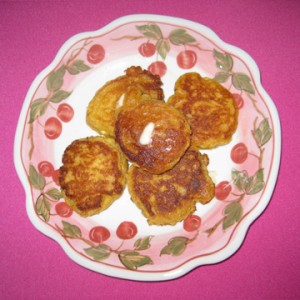
Daughter of Our Country Hoe Cakes
Ingredients:
3/4 cup cornmeal
1/2 cup flour
1/2 teaspoon salt
1/2 teaspoon baking powder
1/2 teaspoon baking soda
1/2 cup buttermilk (plus a little more if you need it)
2 tablespoons unsalted butter, melted and then cooled for a few minutes
1 egg
bacon fat as needed for frying
Instructions:
In a medium-sized bowl combine the cornmeal, flour, salt, baking powder, and baking soda. Whisk until the mixture is integrated and smooth.
In a small bowl (or measuring cup) whisk together the buttermilk, melted butter, and egg.
Make a well in the middle of the dry ingredients, and pour in the buttermilk mixture. Stir just until the mixture is moistened, adding a little more buttermilk if needed to give the batter the consistency of thick pancakes.
In a heavy frying pan or skillet heat a tablespoon or two of bacon fat. When it is good and hot, add the hoe cake batter in little mounds of 2 tablespoons each. Fry for a couple of minutes on each side, adding more bacon fat if needed. Keep finished cakes in a warm oven while you cook their relatives. Make sure the hoe cakes cook through as the batter is thick.
Serve “swimming in butter and honey.” (Actually, they’re not bad on their own.) Makes about 15 hoe cakes.
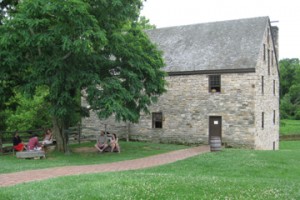
If you enjoyed this post, please consider taking out an email subscription to my blog. Just click on the link below!
Subscribe to In Our Grandmothers’ Kitchens by Email.
